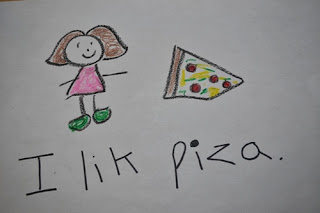Kindergarten students enter the school year with varying levels of ability,
especially when it comes to writing. As a kindergarten teacher, I’ve seen a
range of writing, from scribbling to writing sentences. The key is to begin
with where they are. We all know that kindergartners are full of thoughts and
ideas. They just don’t know how to express what they’re thinking in writing.
After students are comfortable with the writing process, I begin to
introduce them to the mechanics of writing simple sentences. When teaching
students about writing, I explain to them that writing is like telling a story
on paper. I begin by showing them what their thoughts look like. For example, I
have them share an idea while I write it on the chart. In the beginning I
emphasize the content of the writing rather than grammatical correctness.
At the beginning of the school year, I introduce my students to writing
simple sentences. I like to begin the sentence and have my students finish it.
Some starters I use are "I am," "I like," "I
can," and "I want." After several weeks of using sentence
starters, many of my students are confident and ready to begin writing their
own sentences.
Once my students have mastered writing simple sentences, I encourage them
to add a little sparkle to their work. For example, if a student writes “I like
dogs,” have them explain what types of dogs they like. Continue by guiding them
through the creation of a new sentence. For example: “I like brown dogs with
curly hair.”
I also like to use this expanding sentence activity when teaching my
students to add descriptive words. I model this activity with my students
several times to help them understand and master the concept.
Writing is a skill that requires daily practice. Each day my students begin
their morning by writing in their journals. Students are free to write about a
topic of their choice. Journal writing is a great way for your students to
practice articulating their thoughts. Journals encourage students to retell or
create their own stories as well as to practice fine motor skills and letter
formation. Journals can also help teacher’s measure progress and find out more
about their students' interests.
Enjoy,
Nora Sierra
Early Childhood Coordinator


No comments:
Post a Comment